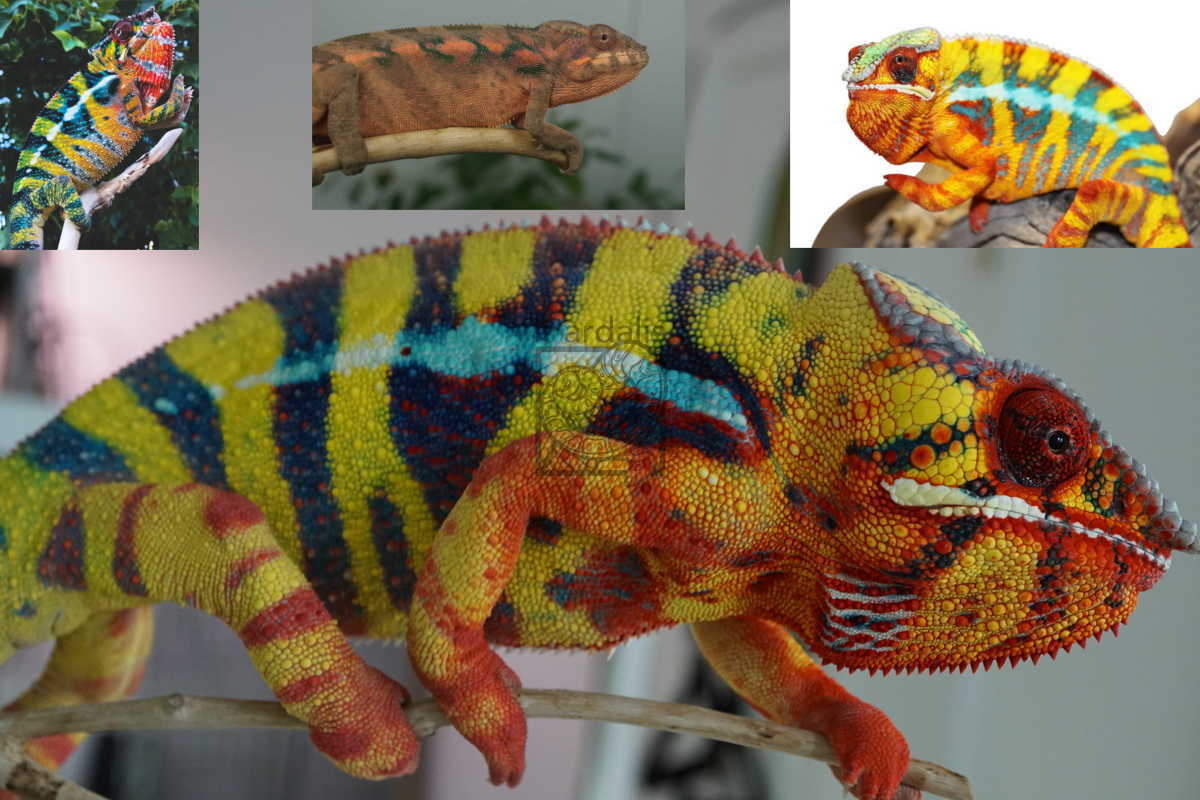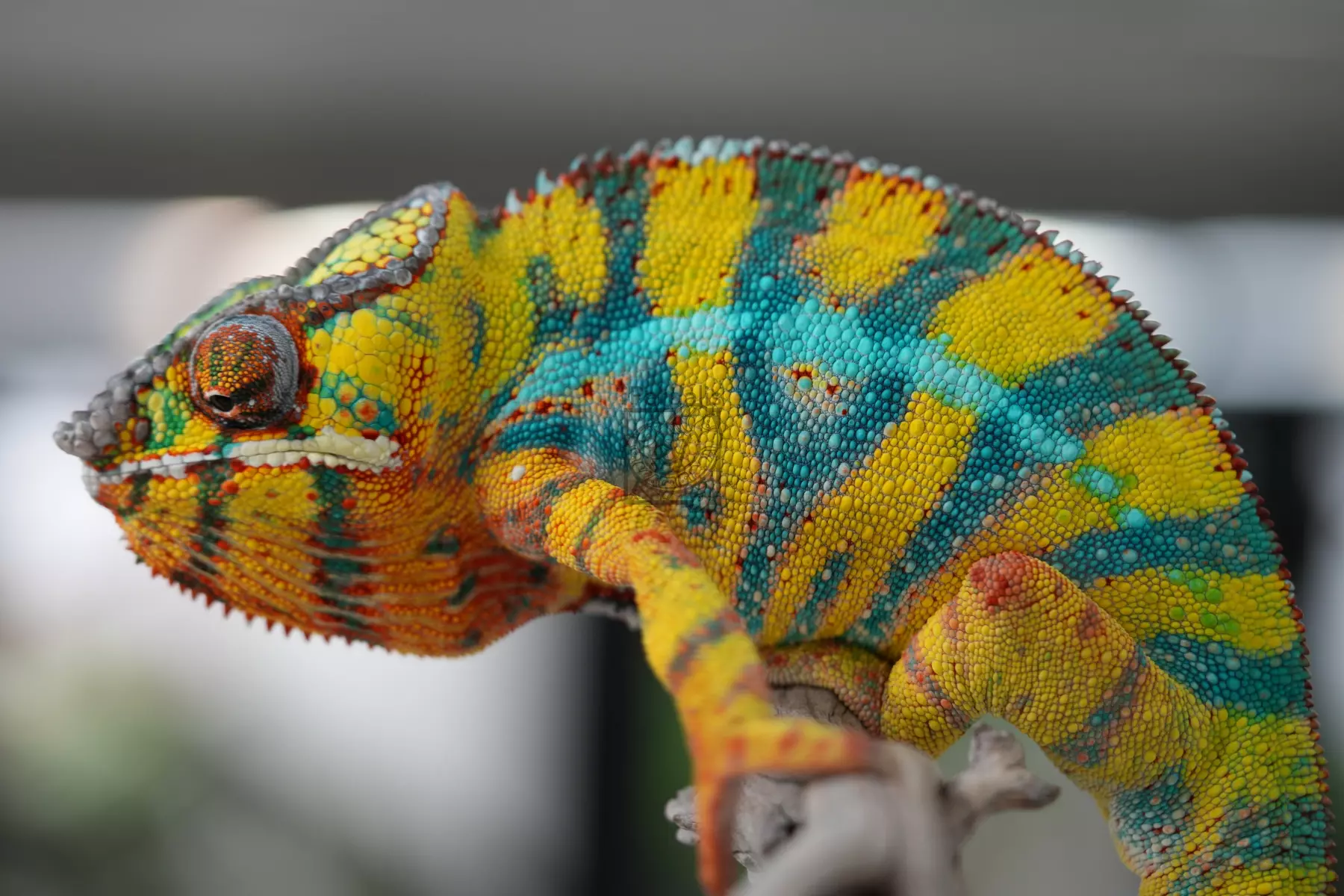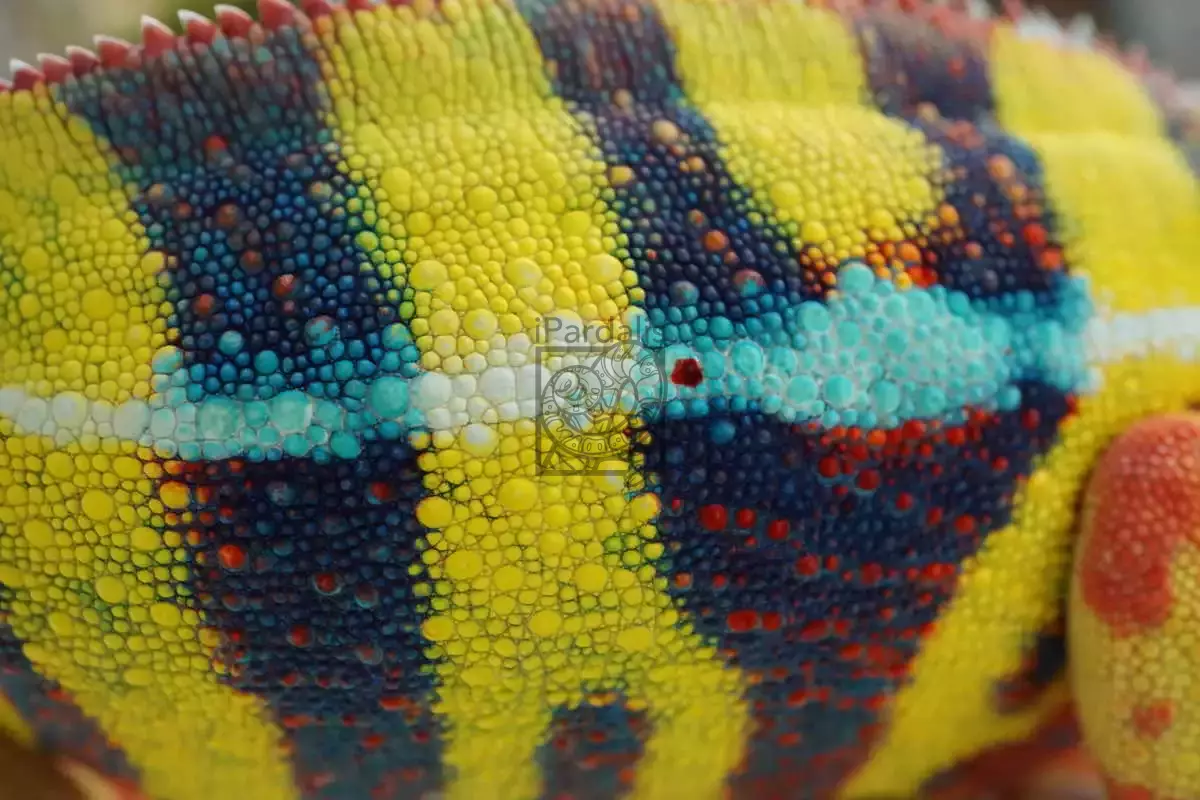| October 14, 2022
The best Panther Chameleon breeders have an in-depth understanding of genetics and inheritance patterns, which allows them to help you achieve your desired outcomes. This knowledge is crucial in the ethics of selling Panther Chameleons, as the industry is rife with misleading advertising and surface-level claims. Unlike the filtered images and click-bait content often seen on platforms like Instagram and TikTok, we prioritize transparency and accuracy. Our Panther Chameleons for sale are carefully selected, well-researched animals that meet the highest standards of quality.
Introduction: The Challenge of Breeding Panther Chameleons
Breeding Panther Chameleons (Furcifer pardalis) isn’t as simple as pairing two colorful adults and hoping for the best. Their vivid coloration, which captivates keepers and collectors around the world, is the result of complex genetics—specifically polygenic inheritance. Unlike simple dominant/recessive traits, polygenic traits create a wide range of outcomes. Breeding for specific colors like yellow body blue bar (YBBB) or red body blue bar (RBBB) isn’t just about luck—it’s about data, observation, and patience.
To make things more complex, Panther Chameleons are sexually dimorphic, meaning females do not display the same coloration as males. So, when trying to breed for male coloration, you’re starting with a major unknown: the female’s contribution to color is hidden. Over time, breeders can estimate a female’s genetic influence by analyzing her male offspring, but this takes multiple clutches and a solid understanding of lineage.
At iPardalis, we’ve dedicated years to refining our breeding program by tracking genetics, observing color development over generations, and avoiding the hype-driven sales tactics often found on social media. This isn’t about filters or flashy marketing—it’s about breeding with purpose, consistency, and transparency.
If you’re new to Panther Chameleon genetics, we recommend reading our Body Color Inheritance Theory to understand the foundational science that shapes every clutch we produce.
Estimating Traits: Building a Genetic Foundation
Every successful Panther Chameleon breeding project starts with a strong hypothesis: What traits does this animal carry, and what will it likely pass on?
When we introduce a new chameleon into our breeding program, we begin with a base estimate—our best guess at the traits it carries based on its appearance and lineage. This estimate is especially important for males, because their coloration is visible. Just like snake breeders learn to identify Pastel or Enchi in Ball Pythons, we need to accurately spot subtle differences in male Panther Chameleons.
The challenge? Not all yellows are created equal.
Many people misidentify colors. If they see even a hint of yellow, they’ll call it a yellow body blue bar (YBBB)—but true neon yellow is rare. Often what people call “yellow” is actually gold or orange, which follows a totally different inheritance path. Worse yet, many breeders lump animals into just a few phenotype buckets—YBBB, RBBB, or YBRB—without realizing most Ambilobe Panther Chameleons fall somewhere in the middle of the color spectrum.
At iPardalis, we strive to only add animals to our YBBB or RBBB projects when we’re 90% confident in their base traits. We carefully analyze lineage and publish detailed lineage collages that visually represent 87.5% of the genetic background, including:
- The sire (father)
- The dam’s sire (maternal grandfather)
- The dam’s dam’s sire (maternal great-grandfather)
These images give buyers and breeders alike a clear look at where our animals come from and what traits they’re likely to carry.

We call this visual estimate the “87.5% picture,” which provides a solid forecast of how offspring will likely turn out—based on genetic probability and observed traits, not guesswork.

| Lineage Pic | Information Gain |
|---|---|
| Sire | 50% |
| Sire’s Sire | 0% |
| Dam’s Sire | 25% |
| Dam’s Dam’s Sire | 12.5% |
| Dam’s Dam’s Dam’s Sire | 6.25% |
This table shows roughly how much information we gain from each key male relative in a lineage tree. Our lineage collages are designed to accurately represent these probabilities with the most prominent picture being the sire with other relevant sires scaled down to reflect their importance.
Notice - sire’s sire provides a 0% information gain. Every trait from the sire’s lineage is visible in him. Looking at the sire’s sire is useless information because panther chameleon colors are not mendelian traits. Traits do not skip down the sire side of a lineage tree. Sire’s sires are only helpful in determining which pairings you want to do from a genetic distance/diversity standpoint, but they are irrelevant for selective breeding purposes.
Updating Trait Estimates Through Offspring
When a female Panther Chameleon is first added to our breeding program, we have limited data. Because females don’t express the vibrant colors males do, we rely on her lineage to estimate what color traits she might carry. But that’s only the beginning.
The real test comes after her first clutch.
Once she produces male offspring, we get our first look at how her hidden traits express themselves. The more male babies we raise and evaluate, the clearer the picture becomes. Around 10 male offspring is our benchmark for forming a reliable estimate of the dam’s genetic contribution—and by extension, the potential of her daughters.
If her sons display a wide range of color—from deep red to bright yellow—that tells us her genetics are too unpredictable for our selective breeding goals. Even if she came from a “yellow-bodied” lineage, the actual distribution of traits in her clutch matters more than her pedigree.
That’s why we don’t keep females from inconsistent clutches. We want precision. If we’re aiming for yellow body blue bar (YBBB) or red body blue bar (RBBB), then we only continue with lines that show consistent, clean coloration across siblings.
Why We Publish All Offspring
At iPardalis, we share all male offspring from every clutch—not just a few flashy favorites. We believe it’s more important to show the full genetic distribution than to highlight the one-in-a-thousand outlier. This transparency gives you a better idea of what to expect if you breed one of our animals.
When we produce an exceptionally consistent clutch—like Jude x Kako—we hold back as many females as possible. We know those girls carry proven, reliable genetics.
Proving Out a Female: Two Key Challenges
Proving a female’s genetics takes time, space, and experience. Most beginner breeders struggle with two core challenges:
- Raising male offspring long enough to see true color expression
- Recognizing what they’re actually seeing
Many males raised in poor conditions—overcrowded or stressed—will only show submissive or dull coloration. Their true genetic potential never has a chance to shine. That’s why identifying clean phenotypes early requires a trained eye and the right environment.
We look for early “zebra” patterns—sharp white highlights with clear, clean barring—which often develop into brilliant, unblended body colors. For example, Ralph, one of our most stunning RBBB males, showed a textbook zebra phase before his colors filled in with glowing orange. These early signs can guide our holdback decisions by the time the animal is just 3 months old.
For YBBB breeding, we also look closely for red creeping in around the gular area or dermal layers. If red is present early, it’s a sign the animal may develop into a rainbow phenotype instead of staying clean yellow.
True neon yellow-green animals have a different chromatophore structure than gold or orange ones, and we’ve never seen one shift into a red-bodied animal. These differences are genetically coded, not temporary color changes.
Why Genetic Diversity Matters in Panther Chameleon Breeding
While consistency is the goal, genetic diversity is the foundation of any sustainable breeding program. Inbreeding may produce quick visual results, but it comes with long-term risks: weakened immune systems, fertility issues, and unpredictable outcomes.
At iPardalis, we occasionally introduce new bloodlines by pairing a trusted female with a less-than-perfect male—but only for strategic reasons.
Intentional Outcrossing with a Purpose
When we do this, the goal isn’t to use both sides of the pairing in future projects. Instead, we focus on evaluating the male offspring to see if they carry the traits we want without the flaws of the sire. If the clutch produces a male that fits our visual and behavioral criteria—say, a clean red body blue bar (RBBB) or yellow body blue bar (YBBB)—he may be used to continue the line.
But the females from these pairings are almost always excluded from future breeding. Why? Because without consistent outcomes from their mother’s side, we can’t predict what they’ll pass on—and that uncertainty breaks our strategy.
We sometimes refer to these as “throwaway clutches,” not because they lack value, but because their role is narrow: to extract one exceptional male while maintaining the integrity of the larger project.
How Close is Too Close?
Of course, even these throwaway sires must be genetically compatible with our program goals. For example, if we’re breeding for yellow body blue bar (YBBB), pairing a red body red bar (RBRB) male to a clean YBBB female is unlikely to produce usable results. The genetic distance is too great, and the likelihood of recovering clean YBBB males is close to zero.
Our approach to outcrossing is thoughtful, conservative, and data-driven. Every pairing has a purpose, and every animal must earn its place in our breeding lines.
The Hidden Factor: Retained Sperm in Panther Chameleons
One of the most overlooked and misunderstood aspects of Panther Chameleon breeding is the ability of female chameleons to retain sperm—a natural phenomenon that can create major confusion for breeders and buyers alike.
What Is Retained Sperm?
A female Panther Chameleon (Furcifer pardalis) can store viable sperm for up to 5 clutches—sometimes over 18 months—after a single mating. That means she can continue producing fertile eggs long after being separated from the original male.
If she’s paired with a new sire during that time, it becomes extremely difficult to determine which male actually fathered her next clutch.
This biological quirk can lead to unreliable lineage claims, especially when breeders are unaware of—or ignore—the possibility of retained sperm.
Why This Matters for Breeding Accuracy
At iPardalis, we take this seriously. Since accurate lineage is essential for selective breeding, we wait until a female shows at least 50% infertility in her clutches before introducing a new male. This helps ensure that any future clutches are truly from the intended sire.
When we do re-pair a female, we prefer to use a closely related male from the same phenotype line. This way, even if retained sperm occurs, the resulting offspring will still be genetically close to our intended project—like a red body blue bar (RBBB) from one RBBB sire vs. another.
Avoiding False Lineage Claims
Many breeders unintentionally report inaccurate lineage because they don’t understand or account for retained sperm. Others may simply assume the most recent pairing is responsible for every egg, which can be wildly misleading—especially in projects focused on specific traits like clean YBBB or RBBB phenotypes.
By designing pairings around this biological reality, we ensure higher accuracy and integrity in our breeding program—and in the animals we offer for sale.
Conclusion: Breeding with Purpose and Precision
Selective breeding of Panther Chameleons isn’t about chasing the flashiest colors or rarest morphs — it’s about understanding genetics, making informed decisions, and committing to the long game. At iPardalis, we’ve built our breeding philosophy on transparency, data, and the consistent pursuit of clean, stable phenotypes like YBBB and RBBB.
Our process is rigorous: we track lineage, analyze clutch outcomes, and prove out females based on real-world offspring results — not guesses or hopes. We publish every male from every clutch, because the entire distribution matters — not just the top 1%.
The result? Healthier chameleons, more predictable traits, and honest expectations for keepers and breeders alike. If you’re serious about understanding Panther Chameleon genetics — or finding a breeder who is — you’re in the right place.
👉 View Our Available Panther Chameleons for Sale
📸 Explore Our Past Clutches



